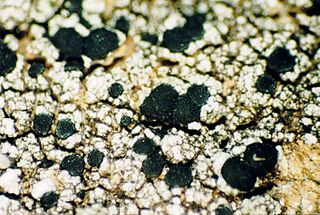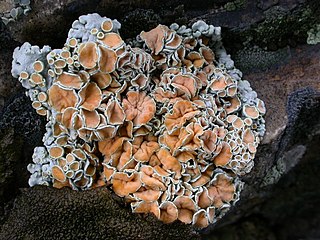A terricolous lichen is a lichen that grows on the soil as a substrate. An example is some members of the genus Peltigera.

The Lecanorales are an order of mostly lichen-forming fungi belonging to the class Lecanoromycetes in the division Ascomycota. The order contains 26 families, 269 genera, and 5695 species.

The Lecanoraceae are a family of lichenized fungi in the order Lecanorales. Species of this family have a widespread distribution.
Bryonora is a genus of crustose lichens in the family Lecanoraceae. The genus was circumscribed in 1983 by lichenologist Josef Poelt, with Bryonora castanea assigned as the type species.

Lecidella is a genus of crustose lichens in the family Lecanoraceae.

Rhizoplaca is a genus of lichenized fungi in the family Lecanoraceae. Members of the genus are commonly called rimmed navel lichens because of their umbilicate growth form and lecanorine apothecia, also rock-posy lichen and rockbright. The genus has a widespread distribution and contains 11 species.
Traponora is a genus of lichen-forming fungi in the family Lecanoraceae. The genus was circumscribed in 2009 by Dutch lichenologist André Aptroot, with the Papua New Guinean Traponora asterella assigned as the type, and at that time, only species. Four newly described species were added to the genus in a 2009 publication, a species formerly in Pyrrhospora was transferred to the genus in 2017, and a new species from Australia added in 2018. Traponora lichens are predominantly from Australasia, with all species but one known to occur in Papua New Guinea.

Rhizoplaca chrysoleuca is a pale yellowish-green to gray-green umbilicate foiliose lichen in the Lecanoraceae family. It was first described in 1791 by English botanist Sir James Edward Smith as Lichen chrysoleucus; Friedrich Wilhelm Zopf transferred it to the genus Rhizoplaca in 1905.
Rhizoplaca shushanii is a species of crustose lichen in the family Lecanoraceae.
Rhizoplaca porteri is a species of crustose lichen in the family Lecanoraceae.
Rhizoplaca parilis is a species of crustose lichen in the family Lecanoraceae.
Rhizoplaca occulta is a species of crustose lichen in the family Lecanoraceae.

Palicella is a genus of crustose lichens in the family Lecanoraceae. It contains five species.
Josef Hafellner is an Austrian mycologist and lichenologist. He was awarded the Acharius Medal in 2016 for his lifetime contributions to lichenology. Before his retirement, he was a Professor at the Karl-Franzens-Universität in Graz. Hafellner started developing an interest in lichens while he was a student at this institution, studying under Josef Poelt. He earned a master's degree in 1975 and a PhD in 1978, defending a doctoral thesis about the genus Karschia. In 2003, Hafellner received his habilitation. By this time, he had studied with French lichenologist André Bellemère (1927–2014) at Saint-Cloud, where he learned techniques of transmission electron microscopy and how their application in studying asci could be used in lichen systematics. His 1984 work Studien in Richtung einer natürlicheren Gliederung der Sammelfamilien Lecanoraceae und Lecideaceae has been described as "probably the single most influential publication in lichen systematics in the latter half of the 20th century".

Rhizocarpales are an order of lichen-forming fungi in the subclass Lecanoromycetidae of the class Lecanoromycetes. It has two families, Rhizocarpaceae and Sporastatiaceae, which contain mostly crustose lichens.
Lecanora achroa is a species of crustose lichen in the family Lecanoraceae. It was originally described in 1876 by Finnish botanist William Nylander from specimens collected in Rodrigues, Mauritius. The lichen is found in Australia, New Zealand, Papua New Guinea, and North and South America.
Miriquidica gyrizans is a species of lichen-forming fungus in the family Lecanoraceae. It is found in Alaska and the Yukon, where it grows on granitic boulders.
Lecanora loekoesii is a species of corticolous (bark-dwelling), crustose lichen in the family Lecanoraceae. Found in South Korea, it was formally described as a new species in 2011 by Lei Lü, Yogesh Joshi, and Jae-Seoun Hur. The type specimen was collected on Mount Taebaek at an altitude of 910 m (2,990 ft); here it was found growing on oak bark. It is only known to occur at the type locality. The specific epithet loekoesii honours Hungarian lichenologist László Lőkös, who collected the type specimen.
Lecidella mandshurica is a species of corticolous (bark-dwelling), crustose lichen in the family Lecanoraceae. It is found in the Russian Far East, South Korea, and China.





